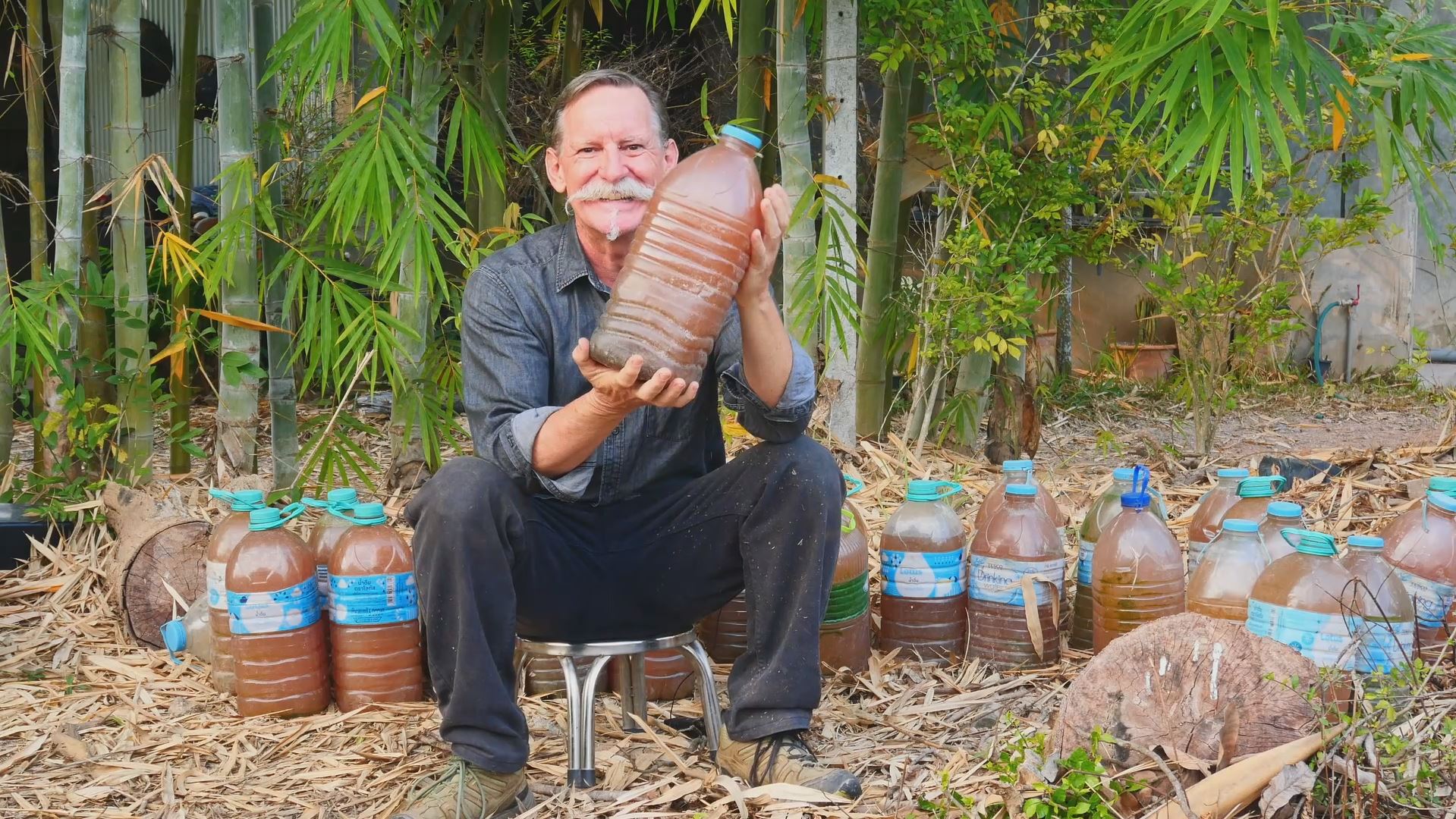How To Make PhotoSynthetic Bacteria Plant Food (PSB)

by
Kevin Landwer-Johan

Photosynthetic bacteria plant food might sound a bit scientific and weird if you are not familiar with it. All it is, without getting at all nerdy, is bacteria that reproduces as it photosynthesizes. This bacteria loves sunshine and multiplies because of it. We use it in our garden to enhance our soil and provide goodness to our plants.
In our gardens at Suan Sook Homestay we prefer to grow everything as naturally as possible. Without the use of chemical fertilizers, pesticides, or herbicides. To feed our plants we use many different organic solutions that help our plants grow and thrive.
What is PSB food? Photosynthetic bacteria (PSB) use sunlight to convert carbon dioxide and water into vigorous organic compounds. This process known as photosynthesis. These bacteria carry out photosynthesis because of pigments such as chlorophyll and bacteriochlorophyll. Since we started our garden here at Suan Sook we’ve been making good use of PSB and have recently been sharing more about how we do this.
Here is a collection of videos to show you how we make photosynthetic bacteria for plants and what we do with it.
How To Make PhotoSynthetic Bacteria (PSB) Plant Food
In this video you’ll learn how to make your own photosynthetic bacteria (PSB) plant food. You’ll also learn about the main reasons this is a great additive to your garden.
It’s pretty simple really. All you need is a collection of bottles to make the plant food in. We reuse large drinking water bottles.
You’ll also need some eggs, fish sauce, msg, and a PSB starter.
All you need is:
- Starter PSB
- Raw egg fish sauce – 1 tablespoon
- Monosodium glutamate (MSG) – 1 tablespoon
- Sunlight
- Water
- and some bottles to make it in.
This is the first video we produced about how to make PSB. It includes using a starter PSB. Each time we make it we use some of the last batch to add to the mixture because it facilitates the process as well as speeding it up.
We had people asking if it’s possible to make PSB without the starter. So we produced another few videos to show how you can produce your own photosynthetic bacteria plant food from scratch. Please click here to learn how you can do this.
Whether you have any PSB to use as a starter or not, this first video will give you a good introduction to this type of organic plant food.
Two Quick Updates About Making PSB Plant Food
Here are two short videos as follow ups to the first one on PSB.
In the first quick update I show the progress and explain two reasons why I know the photosynthetic bacteria plant food is ready to use. These are because the color has changed to a deep red. You’ll need to watch the video to see this color.
The smell of the PSB is another indicator of it’s readiness, but I can’t share this with you via the video … but it stinks when it’s ready.
I also point out that some of the PSB in a few of the bottles did not work as planned. I think this was because I had not cleaned out all of the bottles properly before we made this batch. It’s important to clean the bottles so they are free from contamination.
In this second quick update video I share how to use photosynthetic bacteria for plants in our garden.
Making PhotoSynthetic Bacteria Plant Food From Scratch
In this video we’ll show you how to make your own photosynthetic (PSB) plant food with no starter.
Many people who have viewed our first video about PSB have asked how they can make it without using a starter, so we’ve produced this video to show you how.
All you need is:
- Raw egg fish sauce – 1 tablespoon
- Monosodium glutamate (MSG) – 1 tablespoon
- Sunlight
- Water
- and some bottles to make it in.
This is the same list of ingredients as I shared earlier, without the PSB starter. The method of making the PSB is a little different when you’re making it from scratch, so please make sure to watch this video if you don’t have a starter PSB.
We mix our PSB in 5 liter water bottles, but you can use any clear containers. Do not use opaque bottles. This is a photosynthetic process, so sunlight is a necessary ingredient. If your solution is not receiving enough sunlight it will not reproduce the microbial bacteria.
Mix the fish sauce, egg, and MSG in a bowl. Pour it into a bottle with a lid on it for seven days. Each day take the cap off the bottle to burp it. If you don’t do this the gasses forming in the bottle could cause some problems when you do come to open it.
You’ll need to use water that contains no chemicals. If your only source of water is chlorinated, fill your bottles and let them stand for a week before you add your solution to it. If there’s chemical traces in the water the process may not work as planned. You can fill your bottles on the same day you mix up your solution.
After seven days, mix a table spoon of your solution to five liters of water. Leave the bottles in a location that receives as much sunshine per day as possible.
Step Two
Here’s another short video showing the second step in the process of making photosynthetic bacteria plant food from scratch.
Once you’ve added the solution you need to turn the bottles once a day for 30 days. If they have sufficient sunlight you should see the mixture starting to turn red. If you’re in a location where you’re not getting much sunlight the process will take longer.
For this video we’re experimenting with water from three different sources to see if there’s any differences. One bottle contains water from inside our home. This is water from a bore that is untreated. Another bottle is filled with water from a local farm pond. Two others are filled with water from an irrigation canal at the bottom of our section. One of these bottles also contains some sediment from the canal.
Here’s an update I recorded showing the progress and how the color is changing in each of the bottles after ten days.